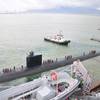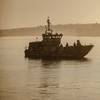Maritime Code Accord Could Solve Pacific Conflicts
Naval officers say accord does not directly address problems in disputed waters, but document could be initial step towards guarding against conflict. U.S. has long stood for clearer operational communications with Chinese fleet.
Countries embroiled in territorial rows in the East and South China Seas agreed on Tuesday to abide by a maritime communications deal to try to ensure accidental naval altercations do not develop into a conflict.
But military officers said the non-binding accord, signed altogether by more than 20 Pacific countries, was no more than a "rules of the road" manual.
It was in no way meant to resolve territorial disputes pitting China against several neighbours over waters where fears of accidental clashes have raised the risk of broader turmoil.
The United States wants clearer operational communications with the growing Chinese fleet, arrangements in part hampered by different interpretations of what sort of movements are acceptable in international waters, U.S. naval officers say.
The risks of a mishap were highlighted in December when the U.S. guided missile cruiser USS Cowpens had to take evasive action in the South China Sea to avoid hitting a warship supporting China's first aircraft carrier, the Liaoning.
China's increasingly assertive navy, which has modernised quickly in the past decade, has sparked nervousness from other countries in the region - particularly Japan.
A U.S. Navy Pacific Fleet official suggested the deal would have little impact on the risks of a collision.
"If your intent is to cause trouble, you're going to cause trouble no matter what," said the official, who asked not to be identified. "It's not meant to bring world peace. It has the express purpose of preventing accidents at sea."
But Gary Li, a senior analyst with IHS Maritime, said the deal would reduce tension.
"This doesn't seem to be a comprehensive code of conduct for all to adhere to by any stretch of the imagination, but rather a much needed de-escalation mechanism," he said.
"For a region where this doesn't currently exist, this is a very important step in the right direction."
China, he said, wanted to separate such a mechanism from the territorial issues. "The lack of legal teeth is not going to be a problem and will allow the Chinese and the other countries more flexibility in these situations."
Signatories, including China, Japan, the Philippines and Malaysia, agreed to the framework at the Western Pacific Naval Symposium in the Chinese coastal city of Qingdao.
A draft of the document, obtained by Reuters, amounts to a handbook for manoeuvres when naval ships and aircraft encounter each other unexpectedly.
Navies are told to fire off flares in green, yellow and red in different situations and given a list of English-language terms. "The document is not legally binding, rather, it's a coordinated means of communication to maximise safety at sea," the draft says.
The final version was not released, but a naval official said the draft's terms were close to what had been agreed.
VOLUNTARY AGREEMENT
On the sidelines of the conference, Xu Hongmeng, vice admiral in the navy of China's People's Liberation Army, said the agreement would have a positive impact on maritime conduct, emphasising that it was voluntary.
But he added that it would have no impact on conduct in the disputed waters of the East and South China Seas.
"You can't say that it's related to the issues in the South and East China Sea - this is about the navies of many countries," Xu said. "This will not influence those issues."
Beijing's increasingly assertive stance on maritime security in what it sees as its territorial waters has stoked concerns in the region as its ships increase patrols in disputed areas.
Chinese and Japanese ships routinely shadow each other near a chain of disputed islets in the East China Sea, a development which analysts have said raises the risk of a conflict.
"The number of communications between the Japanese and Chinese defence forces is small," said Japanese Navy Captain Masahiro Sakurai, without elaborating.
The United States has defence treaties with Japan and the Philippines, raising the prospect of Washington being drawn into a potential conflict if a collision sparks wider tensions.
It is unclear whether this agreement clears up differences in interpretations of military activity. Beijing has objected, for example, to U.S. surveillance operations near its coast, even if Washington insists they are in international waters.
Separately, China and the 10 countries of the Association of South East Asian Nations are negotiating a binding Code of Conduct to ease tensions in the South China Sea before territorial disputes can be resolved.
The code extends far beyond improved communications, seeking to halt military exercises in disputed waters and limit construction on empty reefs and islands, diplomats say.
By Megha Rajagopalan













